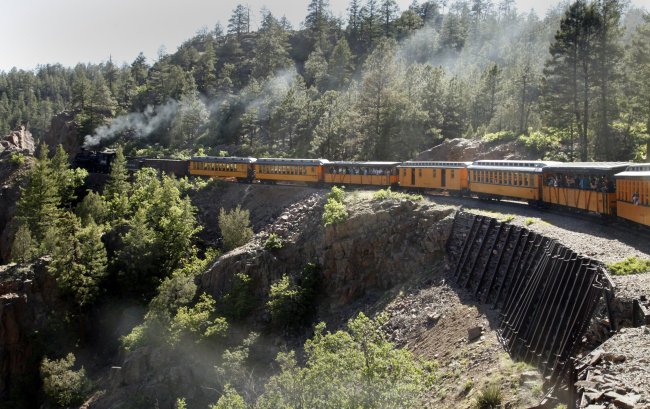DURANGO, Colorado ― Without railroads and mines, what would the American West be? Less populous, less prosperous, less polluted. And the town of Durango might not be anything at all.
Durango, sporty and historic, stands almost 2,000 meters above sea level among the San Juan Mountains of southern Colorado, its downtown streets skirted by the Animas River. Look past the runners, rock climbers, kayakers and fly-fishers, past the rampant Subaru wagons, the snowboarders of winter and the second-home-owners of summer, and you’ll notice the narrow-gauge rail tracks alongside the river, leading into the mountains.
This is the route that brought the town to life in the 1880s. Built by the Denver and Rio Grande Railway in an 11-month blitz of blasting and trestle-construction, this track for decades carried gold and silver from the mines outside Silverton, following a path that clings to cliffs and squeezes through narrow canyons.
Then, after mining began to fade in the late 20th century, the train began its second life, carrying Hollywood film crews and tourists. Nowadays, it carries hundreds of tourists daily ― including L.A. Times photographer Mark Boster and me in late May ― and no ore at all.
Durango, sporty and historic, stands almost 2,000 meters above sea level among the San Juan Mountains of southern Colorado, its downtown streets skirted by the Animas River. Look past the runners, rock climbers, kayakers and fly-fishers, past the rampant Subaru wagons, the snowboarders of winter and the second-home-owners of summer, and you’ll notice the narrow-gauge rail tracks alongside the river, leading into the mountains.
This is the route that brought the town to life in the 1880s. Built by the Denver and Rio Grande Railway in an 11-month blitz of blasting and trestle-construction, this track for decades carried gold and silver from the mines outside Silverton, following a path that clings to cliffs and squeezes through narrow canyons.
Then, after mining began to fade in the late 20th century, the train began its second life, carrying Hollywood film crews and tourists. Nowadays, it carries hundreds of tourists daily ― including L.A. Times photographer Mark Boster and me in late May ― and no ore at all.

The last major Silverton mine closed in 1991, and the old Durango smelter and mill, which processed uranium from the 1940s through the ’60s, have also shut down. Durango (population: about 17,000) has evolved into the sort of town that fuels city people’s semi-rural daydreams.
In the grand old Strater Hotel (built in 1887), just above the Diamond Belle Saloon, you can rent Room 222, where author Louis L’Amour spent many an August in the 1960s and ’70s, writing his western novels and listening to the ragtime piano player downstairs. (But I’d rather sleep in Room 327 ― lots of exposed bricks and woodwork.)
On the 11-kilometer Animas River Trail (no motors allowed), the supply of runners and cyclists seems endless, many of them students at Durango’s Fort Lewis College.
At Mountain Bike Specialists on Main Avenue and 9th Street, you can pick up that SRAM 11-speed rear derailleur you’ve been pining for. Elsewhere along Main, if a storefront doesn’t house a brew pub, field-to-fork restaurant or art gallery, it’s probably a real estate office.
In fact, if you’ve been to Wyoming, you might say Durango is getting Jackson Hole-ier by the day.
As in Jackson, someone, or some plaque, is bound to remind you of the many saloons, whorehouses, feuds and shootouts the city once sustained. One day in 1906, for instance, the county sheriff and the Durango town marshal shot each other in a dispute over who should control local gambling. (The sheriff died. The marshal, Jesse Stansel, moved to Texas.)
And one day in 1922, after an argument involving Prohibition, the Durango Democrat’s top editor, Rod Day, shot to death the Durango Herald’s city editor, William L. Wood.
The big conflicts on the Herald’s front page during my visit were a little different. On one, Durango and Anchorage were competing to be named the “Best Town in America” by readers of Outside magazine (only to be eliminated by Provo, Utah, and Duluth, Minnesota).
On another, hundreds of cyclists were preparing for the 43rd Iron Horse Bicycle Classic, a Memorial Day ritual in which cyclists race the train to Silverton, only to have a snowstorm shorten the route. In a normal year, mountain bike salesman Jeremy Thompson told me, “The fast riders always beat the train. The fastest guys do the race in about 2 hours and 20 minutes.”
The train? Its standard one-way journey to Silverton takes 3 1/2 glorious hours.
Whether or not you recognize the trackside scenery from the dramatic 19th century photographs of William Henry Jackson or old movies such as “Around the World in 80 Days” (1956), odds are good you’ll sigh at the sound of the train whistle, gawk at the coal-burning, steam-belching machinery and then squint into the distance like Clint Eastwood, the better to see the black locomotive chug around a distant curve.
On my ride, I shared one of the train’s open gondola cars with a man from Texas making his 15th trip; his son, a college freshman making his 10th trip; a German couple who wore all sorts of Harley-Davidson insignia and spoke no English; a tall Frenchman whose red sweater kept sneaking into the corners of my photos; and a professorial man from altitude-challenged Holland, who gave voice (in English) to what everyone should have been thinking.
“What an amazing landscape!” he said.
By Christopher Reynolds
(Los Angeles Times)
(MCT Information Services)
-
Articles by Korea Herald



















![[Today’s K-pop] Treasure to publish magazine for debut anniversary](http://res.heraldm.com/phpwas/restmb_idxmake.php?idx=642&simg=/content/image/2024/07/26/20240726050551_0.jpg&u=)